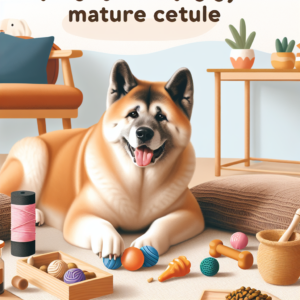Contents
Introduction
Positive reinforcement is a training method that encourages desirable behavior by offering rewards or praise immediately following the desired action. This method has proven to be one of the most effective, humane, and long-lasting ways to train dogs of all breeds, including the Akita. Known for their independent nature, Akitas benefit significantly from positive reinforcement training, as it promotes a strong bond between the dog and their owner while ensuring a well-behaved companion. This article explores the power of positive reinforcement training for Akita dogs, detailing its benefits, suitable rewards, and effective training tools.
Benefits of Positive Reinforcement
Positive reinforcement is more than just a training method; it has profound psychological benefits for both the dog and the owner. Here are some of the main advantages:
Psychological Benefits
Positive reinforcement fosters a sense of trust, security, and happiness for your Akita. Dogs, especially Akitas, thrive in environments where they feel safe and appreciated. By rewarding them for positive behavior, you not only teach them what you want but also boost their confidence. This helps build a strong, trusting relationship, which is essential for effective communication and training.
- Increased Confidence: As your Akita succeeds in following commands and earning rewards, their confidence grows. This leads to a more self-assured dog who is comfortable navigating new situations and responding to their owners.
- Reduced Anxiety: Traditional training methods that use punishment or negative reinforcement can lead to fear, anxiety, and confusion in dogs. Positive reinforcement, on the other hand, strengthens your dog’s mental well-being and emotional stability, reducing the likelihood of anxiety-driven behaviors.
Strengthened Bond Between Owner and Dog
Positive reinforcement training builds a closer relationship between you and your Akita. When your dog receives immediate rewards for their actions, they associate you with positive experiences, which fosters trust and affection. This is especially important for Akitas, who are known to form strong bonds with their owners and can sometimes exhibit aloofness with strangers. By using positive reinforcement, you’re teaching them that good things happen when they interact with you.
Rewards and Treats
Choosing the right rewards and treats is crucial for ensuring the effectiveness of positive reinforcement training with your Akita. Akitas, being highly intelligent, are quick learners when motivated properly, and the right treats can make all the difference.
Types of Rewards and Treats for Akitas
Akitas, like many dogs, enjoy variety in their rewards. However, it’s important to choose treats that are both healthy and appealing to them. Here are some suggestions:
- High-Value Treats: These are special treats used for more challenging training sessions. Look for treats that are soft and easy to chew, such as freeze-dried liver, high-quality jerky, or soft dog biscuits. The higher the value of the treat, the more likely your Akita will perform the desired behavior.
- Low-Value Treats: For simple commands or for repetition, you can use less exciting treats like dry kibble, crunchy dog biscuits, or small pieces of fruit (like apple slices or carrots).
- Natural, Healthy Snacks: Since Akitas are a larger breed, it’s important to consider their dietary needs. Stick to treats that are low in fat and sugar, and avoid any with artificial additives. Natural treats like baby carrots, sweet potato chews, or raw vegetables are great options.
Guidelines for Using Treats Effectively
- Timing: Timing is crucial in positive reinforcement. The treat or reward should be given immediately after the desired behavior occurs, so your Akita can clearly associate the action with the reward. A delay in rewarding can confuse your dog and reduce the effectiveness of training.
- Portion Control: Akitas are a large breed, so it’s important to monitor treat portions to avoid overfeeding and weight gain. Use small portions, so your dog doesn’t consume too many extra calories while still feeling rewarded. You can also adjust the portion of their regular food accordingly when giving additional treats.
- Avoid Overuse of Treats: While treats are effective, they should not be the only reward. Over-reliance on treats can lead to your dog becoming too food-focused, potentially reducing their responsiveness to other forms of reward like praise. Gradually phase out the use of treats as your Akita becomes proficient at a command, and switch to verbal praise, toys, or affection instead.
Clicker Training and Other Tools
Clicker training is one of the most effective tools in positive reinforcement, and it can be incredibly beneficial when training an Akita. The sound of the clicker marks the exact moment a dog performs the correct behavior, which helps them make clear associations between the action and the reward.
Introduction to Clicker Training
A clicker is a small handheld device that makes a sharp “click” sound when pressed. The sound is unique and easy for dogs to distinguish. When used correctly, the clicker becomes associated with positive outcomes, encouraging the dog to repeat the behavior that elicited the click.
Step-by-Step Instructions for Clicker Training:
- Condition the Clicker: Start by simply pairing the sound of the clicker with a treat. Click the device, then immediately give your Akita a treat. Do this several times until they begin to associate the sound with a reward.
- Introduce the Behavior: Once your Akita understands the clicker sound, begin using it when they perform desired behaviors. For example, when your Akita sits on command, click immediately when their bottom touches the floor, and follow it up with a treat.
- Build on Success: As your Akita learns that certain actions trigger the click, you can use the clicker to reinforce more complex behaviors. Gradually phase out treats and use only the clicker and verbal praise as your dog’s understanding deepens.
- Consistency is Key: Always use the clicker at the exact moment your dog performs the desired behavior. This helps your Akita understand what they’re being rewarded for.
Other Positive Reinforcement Tools
While clicker training is a powerful tool, there are other methods to reinforce positive behavior:
- Praise: Verbal praise, such as saying “good boy” or “good girl,” is a simple yet effective way to reward your Akita. Some Akitas are very responsive to tone and may appreciate praise more than treats.
- Toys: Akitas, being a high-energy breed, often enjoy interactive toys like tug ropes or balls. Use these toys as rewards during training to keep things fun and engaging. They also offer mental stimulation, which is great for Akitas who need both physical and mental exercise.
- Physical Affection: Physical touch, like petting or gentle scratching, can also be a highly motivating reward for Akitas. Since they are known for being affectionate with their owners, physical affection can strengthen your bond and act as a great reinforcement tool.
Conclusion
Positive reinforcement is a powerful, effective, and humane method for training Akita dogs. This breed, known for its loyalty and intelligence, responds particularly well to rewards, praise, and clicker training, creating a deep and positive connection between dog and owner. By using rewards and treats appropriately, incorporating tools like the clicker, and ensuring consistency in your approach, you can raise a well-behaved and happy Akita. Remember to maintain a balanced reward system and be patient as you work through the training process. Your Akita’s success will be the result of a loving, trust-filled relationship built on positive reinforcement.


